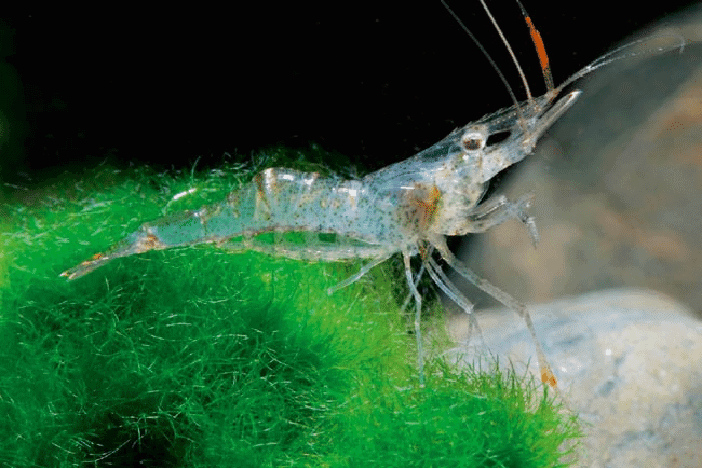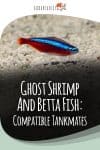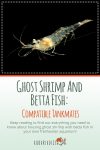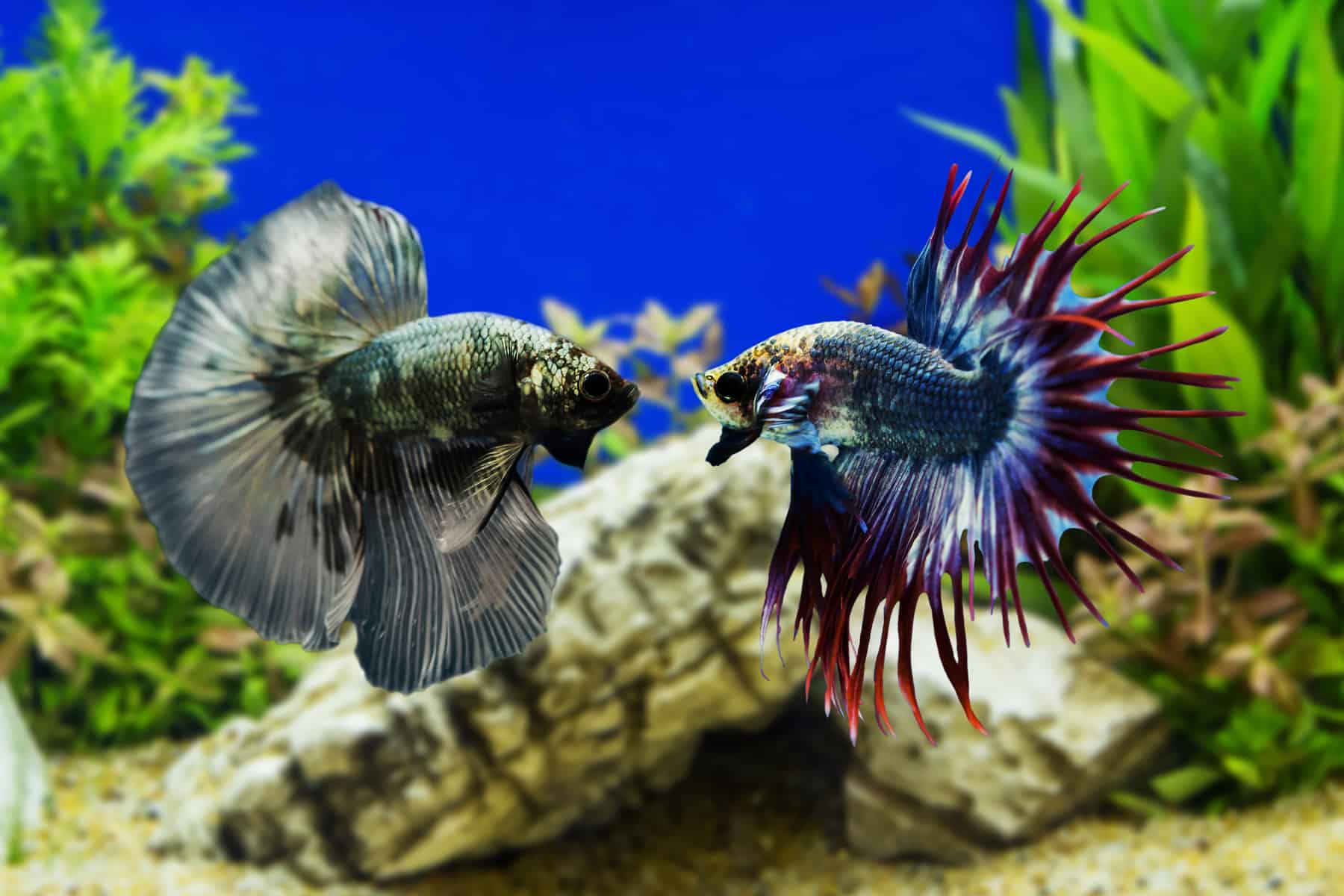You may have heard that ghost shrimp are fantastic tank mates for betta fish or you might have heard that ghost shrimp are horrible tank mates for betta fish; the topic of keeping shrimp with betta fish in the same tank is regularly discussed with many different possible outcomes. We think that if you’re going to try to keep ghost shrimp together with betta fish, you might as well know everything about ghost shrimp and how to increase the likelihood of compatibility.
Keep reading to find out everything you need to know about housing ghost shrimp with betta fish in your own freshwater aquarium!
Ghost shrimp
Palaemonetes paludosus is commonly known as ghost shrimp or glass shrimp. They are usually sold as part of the freshwater aquarium cleanup crew or as inexpensive feeders for larger fish and invertebrates. Some hobbyists even like to have a planted tank solely dedicated to ghost shrimp without any fish at all.
Natural habitat
Ghost shrimp are native to North America, more specifically the southeastern portions of the United States. They have been documented in both freshwater and brackish water conditions and population numbers tend to fluctuate with the seasons. These areas are usually heavily planted lakes and streams with slow water movement where they can hide and eat detritus without getting carried away by the current.
Since these shrimp are so abundant in the wild, they have become a major keystone species for many ecosystems; this means that many predators rely on the ghost shrimp to sustain themselves and then go on to feed other larger apex predators. The ghost shrimp can live for a couple of years on their own, but they are very likely to become food before reaching full adulthood.
Identification
Ghost shrimp are a type of dwarf shrimp species, though they can still get pretty large and fill a lot of space in nano tanks; males grow to be about 1.5 inches (4 cm) while females reach about 2 inches (5 cm). These shrimp are named after their nearly transparent bodies, but some may occasionally have muted underlying tones of yellow, grey, or brown. Females may even display green eggs under their abdomen during spawning periods.
Make sure that you do not confuse ghost shrimp with dwarf crayfish as dwarf crayfish are a little more challenging to happily keep with bettas. For more information about keeping dwarf crayfish with betta fish, make sure to check out our full guide here!
Ghost shrimp tank requirements
Ghost shrimp are a popular addition to the aquarium as they don’t require much extra care. However, it is generally accepted that they need at least 5 gallons (19 L) to comfortably live. They will especially appreciate plants and driftwood that collect biofilm for them to snack on; ghost shrimp do not need special substrate and will do just fine on either gravel or sand.
Ghost shrimp will do best in tropical water temperatures, so the tank should stay stable around 72-82° F (22.2-27.8° C) with pH neutral around 7.0. It is also important to note that ghost shrimp are pretty small and can easily be sucked up into a filter intake. It may be worth considering using a sponge filter instead of a hang on the back filter or canister filter, especially if the tank is small and has a minimal bioload.
Ghost shrimp behavior
Ghost shrimp are a pretty underrated addition to the aquarium and can be as exciting as watching a fish move around. They are more likely to emerge from their hiding places during the night as there is less of a chance to be eaten, but if they are comfortable enough with their surroundings and other fish in the tank, they will regularly be out foraging in the foreground at all times.
Because these shrimp are transparent, it is especially fun to watch as they munch on biofilm and other fallen detritus that you can then watch make its way through their body!
Why does my ghost shrimp curl up?
You might sometimes see your shrimp curl up as if in the typical cooked shrimp position; more than likely, there is no reason to worry and this is simply a part of the molting process. However, if other livestock starts to look sickly, there might be something going on with the water chemistry in your aquarium.
Molting
Every one to two months, you may see your ghost shrimp at various stages throughout its molt. This is when shrimp and other crustaceans shed their exoskeleton in order to grow or heal from an injury. You might even see what appears to be a dead shrimp in the tank, but it may actually just be the shell. If you happen to see an exoskeleton, make sure that all of your ghost shrimp are accounted for. If it is empty, leave it in the tank as the other shrimp will eat it.
For the next day or two after the molt, you might not see your ghost shrimp. This is when they are especially vulnerable and most likely to get picked on by fish. Because of this, they will usually stay towards the back of the tank or in their favorite hiding spot. In a couple of days, they should be back to normal.
Ghost shrimp diet
Ghost shrimp are great members of the aquarium cleanup crew. They will eat biofilm off of plants, rocks, and driftwood without disturbing too much or picking at live plants. This little maintenance will help prevent algae from growing and taking over your tank.
Will ghost shrimp clean my tank?
Yes! Ghost shrimp will definitely help clean your tank by eating leftover food and any detritus that happen to get stuck in the substrate. However, while ghost shrimp will help prevent algae outbreaks by helping keep surfaces clean, they will not actively solve already-existing algae problems.
If you’re currently dealing with an algae problem, make sure to check out our algae eaters and betta fish guide here.
Keeping ghost shrimp with betta fish
When it comes to keeping bettas with any type of shrimp or other invertebrates, there is a lot of conversation and controversy. Some hobbyists have found that their betta fish eats their ghost shrimps as soon as they are introduced into the tank while others have witnessed a slow disappearance of their ghost shrimps over time; then, of course, there are the lucky ones who have kept ghost shrimps with betta fish for years without any problems. For the most part, success depends entirely on the temperament of the betta fish.
However, there are a few ways to increase the chances of successfully keeping ghost shrimp in a betta tank, like overall tank setup and diet. If you’re interested in keeping more colorful shrimp with bettas, then a different species of shrimp might be better for you than the colorless ghost shrimp.
Tank setup
It is usually recommended to have at least a 10 gallon (37.9 L) tank before attempting to introduce any other kind of livestock with your betta fish. This will help create more physical distance between your fish and your shrimp, decreasing the likelihood that they will run into each other throughout the day. If you have an especially aggressive betta fish or one with a voracious appetite, even the slightest movement will spike interest regardless of distance.
As it is, ghost shrimp love their hiding places. Ghost shrimp will stay better hidden in heavily planted tanks with lots of hiding places throughout the aquarium. Not only will plants look beautiful against the colors of your betta, but ghost shrimp may find safety in the areas where bettas can’t easily reach.
Note: If your betta fish is especially aggressive, it may be worthwhile to place a mirror next to the side of the tank every couple of weeks. This will cause your betta fish to become excited and flair, providing extra enrichment. Make sure to never leave the mirror next to the tank for too long as bettas can develop infections if they flair too often.
Diet
While not a proven method, making sure that your betta fish is regularly fed a high-quality diet and an assortment of foods might help deter it from taking a bite at your ghost shrimp. Bettas should be fed small portions, up to three times a day.
While betta fish pellets are regularly sold at local aquarium stores, bettas should have a wide diet that doesn’t overlap too often. They should be fed an assortment of live, frozen, and freeze-dried foods, like brine shrimp, bloodworms, insect larvae, fish flakes, and pellets. Bettas may even enjoy a vegetable snack from time to time as they are omnivorous.
Live foods will especially make your betta excited and might provide the level of enrichment needed to satisfy your betta’s predatory instincts. If your betta is more interested in something else, this might allow your ghost shrimp to stay uneaten! Other high-quality foods will also help keep your betta fuller for longer and less interested in attempting to eat other things in the tank.
However, it is important to note that bettas are prone to becoming overweight. Bettas with longer fins may especially have trouble swimming off extra food due to the added weight of their finnage, so it is important to keep food portions in moderation. Bettas are also prone to becoming constipated, which can usually be helped with time, salt, and/or other natural remedies.
Compatability
Finding good tank mates for betta fish is a tricky task and a sure outcome can never be guaranteed. By optimizing the tank setup and keeping a steady and high-quality diet, ghost shrimp and betta fish may live together. Remember, at the end of the day, finding tank mates that work mainly comes down to the temperament of the betta fish; even if ghost shrimps have been kept with that betta for a long time, it does not mean that the betta will never try to eat them during the life of the tank.
If you’re lucky enough to have a betta that is compatible with ghost shrimp, then you will need to consider how many ghost shrimps you should get for your tank and what happens if the ghost shrimp start to reproduce.
How many ghost shrimp can you have with a betta?
While ghost shrimp are small, it is important to keep in mind that they do produce bioload that your tank will need to be able to process. At the same time, you will want to get a sizeable group so that they have more safety in numbers; also, if your betta eats one, then you are not left without any ghost shrimp at all.
As a general rule, every one gallon (3.8 L) of water will allow for one ghost shrimp. However, this number largely depends on the amount of filtration in the system, including how many plants are growing. A good number to start off with is 4-5 for a nanosystem.
Will betta fish eat baby shrimp?
Yes, if your ghost shrimps reproduce, then your betta fish will eat the babies. Unfortunately, there is not really any way to prevent this from happening unless the female shrimp is removed from the tank before spawning and placed into a separate breeding tank.
Baby shrimps are the perfect snack for bettas and can be much more easily eaten than the adults. However, if you’re lucky, one or two might make their way to adulthood.
Conclusion
Betta fish tank mates can be difficult to find and success largely depends on the temperament of the betta. However, by providing a ghost shrimp-friendly tank and keeping your betta fish well-fed, you may increase the likelihood of keeping your shrimps alive.
If you have any questions about betta fish tank mates, keeping a pet shrimp, or have had experience keeping ghost shrimps with bettas in your own tank, then don’t hesitate to leave a comment below!





















